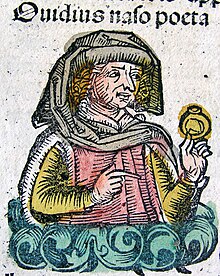ഓവിഡ്
This template must be substituted. Replace {{Requested move ...}} with {{subst:Requested move ...}}.
ആവിഡ് | |
|---|---|
 ആവിഡ് - 1493-ലെ ന്യൂറംബർഗ് നാളാഗമത്തിൽ നിന്ന്. | |
| തൊഴിൽ | കവി |
ഒരു റോമൻ കവി ആയിരുന്നു ആവിഡ് എന്നറിയപ്പെടുന്ന് പബ്ലിയസ് ആവിഡസ് നാസോ (ജനനം: 20 മാർച്ച് ക്രി.വ. 43 – മരണം: ക്രി.വ. 17 അല്ലെങ്കിൽ 18). പ്രേമം, വശീകരണം, അലൗകിക രൂപാന്തരീകരണം എന്നിവയായിരുന്നു അദ്ദേഹത്തിന്റെ ഇഷ്ടവിഷയങ്ങൾ. എലജായിക ഈരടികൾക്ക് (Elegiac couplet) പേരെടുത്ത അദ്ദേഹം, വിർജിലിനും ഹോറസിനും ഒപ്പം ലത്തീൻ ഭാഷയിലെ കാനോനിക കവികളിൽ ഒരാളായി കണക്കാക്കപ്പെടുന്നു. പുരാതനകാലത്തിന്റെ അവസാനവും മദ്ധ്യയുഗങ്ങളിലും ഏറെ അനുകരിക്കപ്പെട്ട ആവിഡിന്റെ കവിത യൂറോപ്യൻ കലയേയും സാഹിത്യത്തേയും കാര്യമായി സ്വാധീനിച്ചിട്ടുണ്ട്.
ആവിഡിന്റെ മിക്കവാറും കവിതകൾ 'എലജായിക' ഈരടികളിൽ (Elegiac couplet) എഴുതപ്പെട്ടവയാണ്: ഇവയിൽ , 'എമോറസ്' എന്ന ഗ്രന്ഥത്തിൽ ഉൾപ്പെടുന്ന 'പ്രേമകല', 'പ്രേമരോഗചികിത്സ' എന്നീ രചനകൾ, പ്രബോധനപരമായ ദീർഘകവിതകളാണ്; ഫാസ്റ്റി എന്ന എന്ന കവിത റോമൻ പഞ്ചാംഗത്തെക്കുറിച്ചാണ്; 'മെഡികാമിനാ-ഫേസീ-ഫെമിനേ' സൗന്ദര്യസംവർദ്ധനികളെക്കുറിച്ചാണ്; പുരാണനായികമാരിൽ നിന്നുള്ള സാങ്കല്പിക കത്തുകളായ 'എപ്പിസ്റ്റുലേ-ഹീറോയിഡം' ആവിഡ് പ്രവാസത്തിലായിരിക്കെ എഴുതിയ അഞ്ചു 'ട്രിസ്റ്റിയ' ഗ്രന്ഥങ്ങൾ , നാല് 'പോണ്ടോ-കത്തുകൾ' 'ഇബിസ്' എന്ന ദീർഘമായ ദുരാലാപനകവിത(Curse Poem - ശാപകവിത) എന്നിവയ്ക്കും 'എലജായിക' ഈരടികൾ തന്നെയാണ് ഉപയോഗിച്ചത്.
എന്നാൽ , 'മീഡിയ' എന്ന ദുരന്തകഥയുടെ ലഭ്യമായ രണ്ടു ശകലങ്ങളുടേത് അയാംബിക് ത്രിവൃത്തവും അനാപെസ്റ്റ് വൃത്തവുമാണ്. 'രൂപാന്തരീകരണം' (Metamorphoses) എന്ന പ്രഖ്യാത കവിതയിൽ ഉപയോഗിച്ചിരിക്കുന്നത്, വിർജിലിന്റെ അനീഡിലെ ഡാക്റ്റൈലിക ഷഡ്വൃത്തമാണ്.
ജീവിതവും കലയും[തിരുത്തുക]
പുരാതന റോമിൽ അപ്പെനൈൻ സമതലത്തിലെ സുൽമോയിലാണ് ആവിഡ് ജനിച്ചത്. വിദ്യാഭ്യാസം റോമിലായിരുന്നു. പിതാവിന്റെ ആഗ്രഹമനുസരിച്ച്, നിയമപഠനത്തിനു തയ്യാറാകാനായി അദ്ദേഹം പ്രസംഗകല അഭ്യസിക്കാനാരംഭിച്ചു. എന്നാൽ പ്രസംഗകലയുടെ സംവാദവശത്തേക്കാൾ അദ്ദേഹത്തെ ആകർഷിച്ചത് വൈകാരികവശമാണ്. സഹോദരന്റെ മരണത്തെ തുടർന്ന് ആവിഡ് നിയമപഠനം ഉപേക്ഷിച്ച് യാത്രകളിൽ ഏർപ്പെട്ടു: ഏഥൻസ്, ഏഷ്യാമൈനർ, സിസിലി തുടങ്ങിയ സ്ഥാലങ്ങളെല്ലാം അദ്ദേഹം സന്ദർശിച്ചു. താഴേക്കിടയിലെ ചില ജോലികൾ ചെയ്ത അദ്ദേഹം ഒടുവിൽ കവിതയിൽ ഉറച്ചു. മാർക്കസ് വലേരിയസ് മെസ്സല്ലാ കൊർവീനസ് എന്ന ആശ്രയദാതാവിന്റെ ചുറ്റിപറ്റിയുള്ള ഒരു സംഘത്തിൽ അദ്ദേഹവും പെട്ടിരുന്നു. മുപ്പത് വയസ്സിനുള്ളിൽ അദ്ദേഹം മൂന്നുവട്ടം വിവാഹിതനും രണ്ടുവട്ടം വിവാഹമോചിതനുമായി; ഒരു വിവാഹം മാത്രമേ ആവിഡിനു സന്താനഭാഗ്യം നൽകിയുള്ളു — ഒരുമകളാണ് അദ്ദേഹത്തിനുണ്ടായിരുന്നത്. [1]
എമോറസ് എന്ന ഗ്രന്ഥത്തിന്റെ മൂലരൂപം അഞ്ചുഭാഗങ്ങളായി ക്രി.മു. 20-നടുത്തെഴുതിയതാണ്; അതിന്റെ ഇപ്പോൾ ലഭ്യമായ രൂപത്തിൽ അതിന് മൂന്നു ഭാഗങ്ങളേ ഉള്ളൂ. ക്രി.വ.1-ൽ എഴുതിയ കവിതകൾ വരെ അതിലുണ്ട്. ഒന്നാം പുസ്തകത്തിൽ പ്രേമത്തിന്റെ വിവിധവശങ്ങളെക്കുറിച്ചുള്ള 15 കവിതകളാണ്. "കൊട്ടിയടക്കപ്പെട്ട വാതിലിനുമുൻപിൽ നിന്നു കരയുന്ന കാമുകൻ" തുടങ്ങി, പ്രേമപീഡയെ സംബന്ധിക്കുന്ന കവിതകളിലെ സാധാരണ പ്രമേയങ്ങളെല്ലാം ഈ കവിതകളിലുണ്ടെങ്കിലും, അവയിൽ തന്റെ കല്പനാവൈഭവം പ്രകടിപ്പിക്കുക മാത്രമേ ആവിഡ് ചെയ്യുന്നുള്ളൂ. അക്കാലത്തെ മറ്റു ചില കവികളെപ്പോലെ കവി സ്വയം പ്രേമാതുരന്റെ വൈകാരികാവസ്ഥയിൽ എത്തുന്നില്ല. മിക്കവാറും കവിതകൾ ദ്വയാർഥത്തോടെ എഴുതപ്പെട്ടവയാണ്. ആയിടെ നിലവിൽ വന്ന അഗസ്തസിന്റെ വിവാഹനിയത്തിൽ നിരോധിക്കപ്പെട്ടിരുന്ന വ്യഭിചാരത്തെക്കുറിച്ചും ആവിഡ് എഴുതുന്നുണ്ട്.
എമോറസിന്റെ, 'പ്രേമകല' എന്ന രണ്ടാം ഭാഗമാകട്ടെ, പ്രബോധനകവിതയെ ഹാസ്യരൂപത്തിൽ അനുകരിക്കുന്നതിനൊപ്പം റോമിൽ പ്രേമഭാജനങ്ങളെ കണ്ടെത്തി, വശീകരിച്ച് സ്വന്തമാക്കുന്നതിലേക്കുള്ള വഴികാട്ടിയാകുന്നു;[2] ഈ കൃതിയുടെ പ്രേമരോഗചികിത്സ എന്ന മൂന്നാം ഭാഗം, പ്രേമത്തിലെ തിരിച്ചടികളെ 'സ്റ്റോയിക്ക്' സമചിത്തതയോടെ നേരിടാൻ സഹായിക്കുന്ന നിർദ്ദേശങ്ങളാണ്.
ചിത്രശാല[തിരുത്തുക]
-
ആന്റൺ ഫോൺ വെർണർ രചിച്ച ഓവിഡ് എന്ന ചിത്രം.
-
ലൂക്ക സിഗ്നോറെല്ലി രചിച്ച ഓവിഡ് എന്ന ചിത്രം.
-
ജോഹാൻ ഹൈന്രിച്ച് ഷോൺഫെൽഡ് രചിച്ച ചിത്രം സ്കൈത്തിയൻസ് അറ്റ് ദി ടൂമ്പ് ഓഫ് ഓവിഡ് (1640).
അവലംബം[തിരുത്തുക]
- ↑ http://www.jstor.org/view/00173835/ap020138/02a00070/0
- ↑ Hornblower, Simon (1999). Oxford Classical Dictionary. Oxford University Press. pp. 1084–1086.
{{cite book}}: Unknown parameter|coauthors=ignored (|author=suggested) (help)
കുടുതൽ വായനയ്ക്ക്[തിരുത്തുക]

- Brewer, Wilmon, Ovid's Metamorphoses in European Culture (Commentary), Marshall Jones Company, Francestown, NH, Revised Edition 1978
- More, Brookes, Ovid's Metamorphoses (Translation in Blank Verse), Marshall Jones Company, Francestown, NH, Revised Edition 1978
- Ovid Renewed: Ovidian Influences on Literature and Art from the Middle Ages to the Twentieth Century. Ed. Charles Martindale. Cambridge, 1988.
- Richard A. Dwyer "Ovid in the Middle Ages" in Dictionary of the Middle Ages, 1989, pp. 312–14
- Federica Bessone. P. Ovidii Nasonis Heroidum Epistula XII: Medea Iasoni. Florence: Felice Le Monnier, 1997. Pp. 324.
- Theodor Heinze. P. Ovidius Naso. Der XII. Heroidenbrief: Medea an Jason. Mit einer Beilage: Die Fragmente der Tragödie Medea. Einleitung, Text & Kommentar. Mnemosyne Supplement 170 Leiden: Brill Publishers, 1997. Pp. xi + 288.
- R. A. Smith. Poetic Allusion and Poetic Embrace in Ovid and Virgil. Ann Arbor; The University of Michigan Press, 1997. Pp.ix+ 226.
- Michael Simpson, The Metamorphoses of Ovid. Amherst: University of Massachusetts Press, 2001. Pp. 498.
- Philip Hardie (ed.), The Cambridge Companion to Ovid. Cambridge: Cambridge University Press, 2002. Pp. xvi, 408.
- Ovid's Fasti: Historical Readings at its Bimillennium. Edited by Geraldine Herbert-Brown. Oxford, OUP, 2002, 327 pp.
- Susanne Gippert, Joseph Addison's Ovid: An Adaptation of the Metamorphoses in the Augustan Age of English Literature. Die Antike und ihr Weiterleben, Band 5. Remscheid: Gardez! Verlag, 2003. Pp. 304.
- Heather van Tress, Poetic Memory. Allusion in the Poetry of Callimachus and the Metamorphoses of Ovid. Mnemosyne, Supplementa 258. Leiden: Brill Publishers, 2004. Pp. ix, 215.
- Ziolkowski, Theodore, Ovid and the Moderns. Ithaca: Cornell University Press, 2005. Pp. 262.
- Desmond, Marilynn, Ovid's Art and the Wife of Bath: The Ethics of Erotic Violence. Ithaca: Cornell University Press, 2006. Pp. 232.
- Rimell, Victoria, Ovid's Lovers: Desire, Difference, and the Poetic Imagination. Cambridge: Cambridge University Press, 2006. Pp. 235.
- Pugh, Syrithe, Spenser and Ovid. Burlington: Ashgate, 2005. Pp. 302.
- Montuschi, Claudia, Il tempo in Ovidio. Funzioni, meccanismi, strutture. Accademia la colombaria studi, 226. Firenze: Leo S. Olschki, 2005. Pp. 463.
- Pasco-Pranger, Molly, Founding the Year: Ovid's Fasti and the Poetics of the Roman Calendar. Mnemosyne Suppl., 276. Leiden: Brill Publishers, 2006. Pp. 326.
- Martin Amann, Komik in den Tristien Ovids. (Schweizerische Beiträge zur Altertumswissenschaft, 31). Basel: Schwabe Verlag, 2006. Pp. 296.
- P. J. Davis, Ovid & Augustus: A political reading of Ovid's erotic poems. London: Duckworth, 2006. Pp. 183.
- Lee Fratantuono, Madness Transformed: A Reading of Ovid's Metamorphoses. Lanham, Maryland: Lexington Books, 2011.
- Peter E. Knox (ed.), Oxford Readings in Ovid. Oxford: Oxford University Press, 2006. Pp. 541.
- Andreas N. Michalopoulos, Ovid Heroides 16 and 17. Introduction, text and commentary. (ARCA: Classical and Medieval Texts, Papers and Monographs, 47). Cambridge: Francis Cairns, 2006. Pp. x, 409.
- R. Gibson, S. Green, S. Sharrock, The Art of Love: Bimillennial Essays on Ovid's Ars Amatoria and Remedia Amoris. Oxford: Oxford University Press, 2006. Pp. 375.
- Johnson, Patricia J. Ovid before Exile: Art and Punishment in the Metamorphoses. (Wisconsin Studies in Classics). Madison, WI: The University of Wisconsin Press, 2008. Pp. x, 184.
പുറത്തേയ്ക്കുള്ള കണ്ണികൾ[തിരുത്തുക]
- University of Virginia, "Ovid Illustrated: The Renaissance Reception of Ovid in Image and Text"
- Ovid എന്ന വ്യക്തിയുടെ രചനകൾ പ്രോജക്ട് ഗുട്ടൻബർഗിൽനിന്ന്
- Nihon University, "Ovid Metamorphoses: Paris 1651(1619) Archived 2017-11-01 at the Wayback Machine.
- Latin and English translation
- Perseus/Tufts: P. Ovidius Naso Amores, Ars Amatoria, Heroides (on this site called Epistulae), Metamorphoses, Remedia Amoris. Enhanced brower. Not downloadable.
- Sacred Texts Archive: Ovid Archived 2012-10-22 at the Wayback Machine. Amores, Ars Amatoria, Medicamina Faciei Femineae, Metamorphoses, Remedia Amoris.
- The Metamorphoses of Publius Ovidius Naso Archived 2007-07-22 at the Wayback Machine.; elucidated by an analysis and explanation of the fables, together with English notes, historical, mythological and critical, and illustrated by pictorial embellishments: with a dictionary, giving the meaning of all the words with critical exactness. By Nathan Covington Brooks. Publisher: New York, A. S. Barnes & co.; Cincinnati, H. W. Derby & co., 1857 (a searchable facsimile at the University of Georgia Libraries; DjVu & layered PDF Archived 2006-03-05 at the Wayback Machine. format)
- Original Latin only
- Latin Library: Ovid Amores, Ars Amatoria, Epistulae ex Ponto, Fasti, Heroides, Ibis, Metamorphoses, Remedia Amoris, Tristia.
- Works by Ovid
- English translation only
- New translations by A. S. Kline Amores, Ars Amatoria, Epistulae ex Ponto, Fasti, Heroides, Ibis, Medicamina Faciei Femineae, Metamorphoses, Remedia Amoris, Tristia with enhanced browsing facility, downloadable in HTML, PDF, or MS Word DOC formats. Site also includes wide selection of works by other authors.
- Two translations from Ovid's Amores by Jon Corelis. Archived 2012-12-08 at Archive.is
- English translations of Ovid's Amores with introductory essay and notes by Jon Corelis Archived 2020-03-09 at the Wayback Machine.
- Perseus/Tufts: Commentary on the Heroides of Ovid
- SORGLL: Ovid, Metamorphoses VIII, 183–235, (Daedalus & Icarus); read by Stephen Daitz Archived 2012-02-15 at the Wayback Machine. Archived 2012-02-15 at the Wayback Machine.



